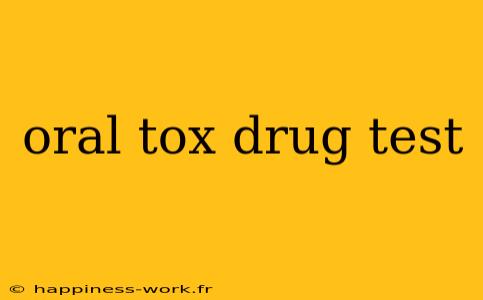Introduction
Oral tox drug tests, commonly known as saliva drug tests, are increasingly used in various settings such as workplaces, schools, and law enforcement to detect the presence of drugs in an individual's system. This non-invasive testing method has its advantages, but many still have questions about its reliability, procedures, and implications. In this article, we’ll explore the essentials of oral tox drug tests, answer common questions, and provide practical insights based on the latest information.
What Is an Oral Tox Drug Test?
An oral tox drug test is a diagnostic tool that analyzes saliva samples to detect the presence of drugs or their metabolites. Saliva tests can detect recent drug use, typically within the past few days, depending on the substance tested.
Common Drugs Detected
Most oral drug tests can detect the following substances:
- THC (the psychoactive component of marijuana)
- Cocaine
- Opiates (such as heroin and morphine)
- Amphetamines
- Benzodiazepines
- Methamphetamine
How Does the Testing Process Work?
The testing process generally involves several key steps:
- Collection: A swab or device is placed in the individual's mouth for a specific duration to absorb saliva.
- Analysis: The collected sample is analyzed in a lab or using an on-site testing kit.
- Results: Results can often be provided within minutes (for on-site tests) or a few days (for lab testing).
Advantages of Oral Tox Drug Testing
- Non-invasive: Compared to urine or blood tests, oral tests are less invasive and more comfortable for the individual.
- Quick results: Many oral tests provide results much faster than traditional methods.
- Lower potential for tampering: Since the test is conducted in real-time, the chances of sample alteration or substitution are minimized.
Frequently Asked Questions
1. How Accurate Are Oral Tox Drug Tests?
Answer: Oral tox drug tests are generally reliable, especially for detecting recent use. However, factors such as the individual’s metabolism, the drug used, and the time elapsed since use can affect accuracy. It's essential to follow up with more comprehensive testing if a positive result is obtained.
2. How Long Do Drugs Stay in Saliva?
Answer: The duration drugs remain detectable in saliva varies by substance:
- Marijuana: Up to 72 hours
- Cocaine: 1 to 2 days
- Amphetamines: 1 to 3 days
- Opiates: 1 to 3 days
3. Can You Pass an Oral Tox Test After Using Drugs?
Answer: The possibility of passing an oral tox drug test depends on the substance used and the time elapsed since use. Some individuals may metabolize drugs more quickly, but there are no guarantees.
Additional Insights
The Importance of Context in Drug Testing
Understanding the context of drug testing is crucial. For instance, a workplace may implement random oral drug testing to promote a safe environment. However, the reasons for drug testing can vary across sectors, affecting policies and procedures.
Legal Considerations
Individuals should be aware of the legal implications of drug testing in their region. In many places, employers can legally require drug tests, but laws differ in terms of notice and consent requirements.
Preparing for an Oral Tox Drug Test
If you anticipate being tested, it's wise to know the testing policies and take necessary precautions, such as avoiding drugs you know can show up in the test.
Conclusion
Oral tox drug tests play a significant role in modern drug detection efforts, offering a quick and non-invasive alternative to traditional testing methods. While they have limitations, their advantages make them a popular choice for various organizations. By understanding the specifics of how these tests work and their implications, individuals can better prepare and respond to drug testing situations.
Attribution: This article synthesizes information and insights based on common questions and answers from WikiHow. Please note that additional insights and analysis have been added to enhance understanding and provide value beyond the original content.
